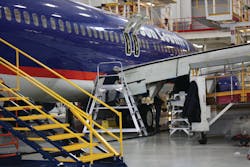Nestled in the hardwood trees on Duluth International Airport, this Minnesota maintenance facility first occupied by the former Northwest Airlines in 1996 is now the fifth heavy maintenance location in the AAR Aircraft Services network. AAR started exploring Duluth as an option to expand its MRO network in the spring of 2011 looking at different locations for different types of work. The Duluth facility was being considered for narrow body heavy maintenance, while other locations were considered for different airframe types.
Danny Martinez, AAR vice president technical services, says, “The first step was to go out there and see what types of facilities and locations were available. Once identified, the bigger question became which locations have the best talent pool. There are many unused aircraft maintenance facilities across the United States but not all have talent to support them. The facility is certainly important but we were looking for a stable experience talent pool.”
According to Martinez the reasons behind expanding into a fifth facility were twofold; to provide an additional location customers can count on for steady nose-to-tail heavy check work, and to provide the ability to level-load across their existing MRO network. Martinez shares, “We were not sure what the work would be but we were confident the work would come. Customers know enough about our company to trust us. We were looking for at least one tier-one customer to build a long-term relationship with here in Duluth.”
AAR worked directly with the Duluth Economic Development Authority (DEDA), the owner of the facility. DEDA is in the business of developing the local economy and Martinez feels that working with one entity really simplified the process. Once selected, AAR moved rapidly. The building lease was signed in July 2012, the facility received its FAA Repair Station Certificate on Sept. 27, 2012, and the first aircraft induction was two months later.
Martinez comments, the FAA repair station certification went very well and everyone was pleased with the process. He says, “All baseline processes from their 1MRO network were easily brought forward to Duluth. The 1MRO concept employed across the entire AAR MRO network showed the FAA we had best-practices processes in place even though the facility was rather empty.”
The talent pool
The first task was getting the critical mass of technicians in the door and the focus was hiring experienced A&Ps. Early in the process a job fair was held which resulted in approximately 600 inquiries or resumes, many from local people with the type of aircraft maintenance experience needed. At the time of my visit, the Duluth facility was staffed to 130 employees. Direct employees make up the majority of the workforce. Approximately 80 percent of the current workforce is former airline employees. From AMTs to senior management positions Martinez feels these former airline employees have brought an immediate credibility to the workforce. He also shares the reception by the AMTs has been great and he sees many long-time relationships between employees. Martinez says, “This first group of people has been a joy to work with, many are coming back home to the area, and everyone seems happy to be here.”
Bill Armold, one of the many former airline employees, shares he was away from aviation for seven years but wanted to stay in northern Minnesota. Armold says, “I’m very happy to be back working on aircraft in the same facility I worked in for many years.” Dave Ruvskanen says, “I started working as an AMT for Great Lakes Airlines right here in Duluth, moved to the Seattle area to work for an MRO and really liked the work, but wanted to come back to the area. Eventually I moved back and worked for Cirrus Aircraft for 13 years. I was thrilled to see an MRO move into the facility.”
AAR did feel the need to address the shift from airline thinking to MRO thinking when hiring this many former airline people. Part of the new hire indoctrination training was an explanation of the business model differences between an MRO and an airline maintenance organization, and what it takes to be profitable as an MRO.
Plans for Duluth
Martinez says they are all very proud to see the building put back to use for what it was intended, and to see the talented people here doing what they like to do. It’s exciting for the city of Duluth, for Minnesota, and for AAR.
The long-term plan is to build up to a top-notch facility primarily dedicated to one core customer and fill the multiple check line gaps with AOG, drop-in, and modification work. They intend on keeping three to four steady check lines of maintenance going full time and appear to be on-track with this plan anticipating having three steady lines of heavy maintenance this year. AAR feels this facility has the size and the area has the talent to generate the revenue necessary to stand on its own two feet. The facility has ample space for developing any number of back shop capabilities as the need increases.
Estimates are a full complement at the Duluth facility will be approximately 250 employees. Discussions have begun with the local Air National Guard unit, Northland Community & Technical College, and Lake Superior College on ideas for programs to create the pipeline of future aircraft maintenance technicians.
AAR’s outlook for narrow body MRO
I discussed with both Danny Martinez and Chris Jessup, senior vice president sales and marketing for MRO division, what they see as industry trends and to share their outlook for narrow body maintenance in North America. Both feel there continues to be a need for narrow body heavy maintenance and modification services. Martinez says, “All the MROs seem to be busy and capacity in North America is getting filled. I talk to our competitors and other MROs in the industry and everyone is busy.”
Jessup agrees with this view and says, “The outlook remains strong and I don’t see demand going down.” Jessup adds that a significant volume is taken up in the market with modifications and upgrades. For example, across the AAR MRO network the current annualized labor run-rates are greater than 4.5 million man-hours and 30 percent of these man-hours come from modifications and upgrades, most times embedded into C-check packages.
Jessup went on to share a few more interesting points and observations. In the last 12 to 24 months more carriers are interested in developing relationships and long-term commitments to maintain a dedicated fleet or to provide an MRO with steady lines of work for years. The movement by airlines from one MRO to another chasing cost has slowed. Airline customers have always wanted a quality, reliable, on-time aircraft and still do. But today they want more. Many want a one-stop-shop with engineering support, parts and material support, logistics, and component repair and overhaul. Airlines want to know how the MRO can provide detailed data and performance metrics, and look to partner with an MRO having IT systems that interface with the air carriers systems.
It appears the ability for an MRO to provide more services and manage the complex interface has become an increasingly large part of the MRO airline relationship.
1MRO
With AAR Aircraft Services facilities in Duluth, MN; Hot Springs, AR; Indianapolis, IN; Miami, FL; and Oklahoma City, OK, the 1MRO concept is employed across the entire network driving consistent processes and consistent levels of customer service regardless of location. Individual locations are not viewed as stand-alone groups but as 1MRO.
Internally developed and customizable IT systems such as StAAR and APRISe are key components to the 1MRO concept. The systems house information for virtually all MRO processes and allow for easy transfer of processes and people. AAR complements its MRO operations with landing gear, component repair, and engineering services businesses that also operate as part of its 1MRO network.
Its StAAR program manages the complexities of the airframe MRO and allows full oversight of the maintenance process including labor tracking, project tracking, material and labor collection, repair station procedures, quality manuals, calibrated and noncalibrated tool tracking, training and qualification records for technicians, nonroutine discrepancy tracking, customer work-deck management, production planning, and can provide customers the ability to review work cards, material certification, and invoicing and billing. StAAR is also fully integrated with AAR’s inventory management application (IMOPS).
APRISe is the system that houses and manages all quality, safety, and event data such as maintenance errors, internal, external, and FAA audits, internal and external corrective action requests, human factors investigations, environmental health and safety issues. APRISe will track corrective action progress and continues to notify responsible individuals of corrective action due dates while escalating due date notices until resolution.
Stan Schmoe, director of quality at AAR Duluth, describes StAAR and APRISe as great management tools and provides a few examples. Technician training and qualification records are housed in the system and it won’t allow a technician to log into a job if he or she is not qualified regardless of location. Tools cannot be issued if they are past due for calibration and a technician cannot clock out at the end of a shift if an item has not been returned. Inspectors using electronic tablets are automatically notified when a task card is ready for an inspection buy-back. APRISe has the ability to show quality and safety trends, an effective tool to help predict where potential risks may occur.
About the Author
Ronald Donner
Aviation Consultant | AMT
Ronald (Ron) Donner has spent his entire life devoted to aviation and he holds FAA certificates as an A&P/IA, and a Commercial Pilot with Single and Multi Engine Land, Instrument Airplane and Glider ratings. Ron has worked in a variety of maintenance related roles, both technical and management in general aviation as well as with a major airline. Ron was the recipient of the 2012 National Air Transportation Association (NATA) Aviation Journalism award.
Contact: Ron Donner
Chief Editor | Aircraft Maintenance Technology
+1-612-670-6048
>> To download the AviationPros media kits, visit: Marketing Resource Center
>>Check out our aviation magazines: Ground Support Worldwide | Airport Business | Aircraft Maintenance Technology

